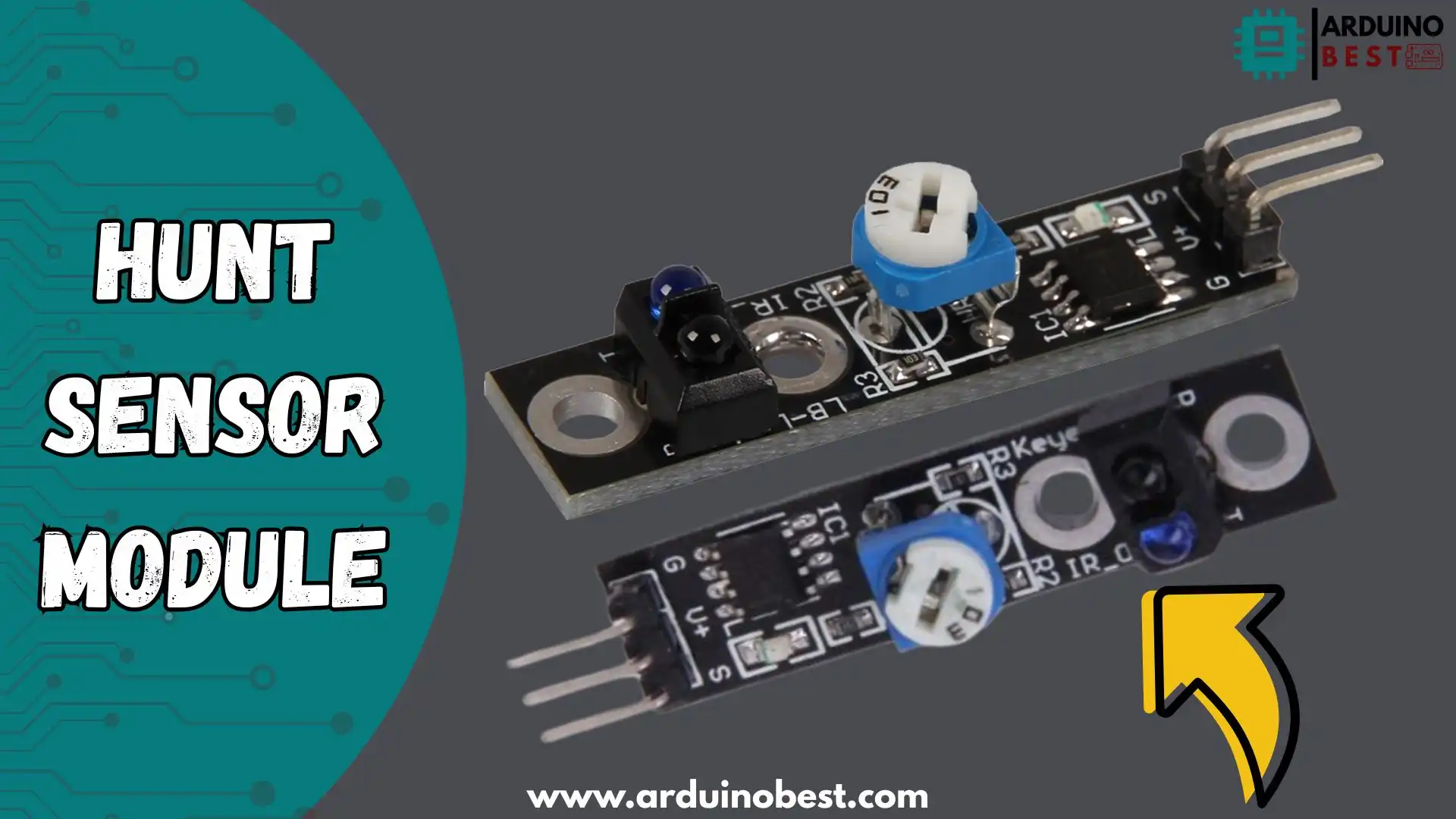The Hunt Sensor Module is a versatile and reliable infrared sensor used in various applications, particularly in robotics, automation, and electronics. By detecting the presence of obstacles and distinguishing between different surface colors (typically black and white), the Hunt Sensor Module plays a key role in projects such as line-following robots, object detection systems, and automated navigation. With its ability to integrate seamlessly with microcontrollers like Arduino, it offers an efficient and easy solution for many electronic projects.
The basic functionality of the Hunt Sensor Module is centered around infrared light detection. It emits infrared light, which is then reflected back by a surface. The sensor then measures the intensity of the reflected light, allowing it to differentiate between various surface types. This process is crucial in a range of applications, from smart robotics to simple detection systems. If you’re interested in learning more about how infrared sensors like the Hunt Module work, check out this detailed guide on infrared sensor technology.
What is a Hunt Sensor Module?
The Hunt Sensor Module is an infrared-based sensor that uses an emitter and a receiver to detect obstacles and surfaces. It is primarily used in line-following robots and systems requiring surface color detection. Its ability to distinguish between black and white surfaces is what makes it particularly useful in robotic navigation and object detection.
Typically, the module operates by sending out infrared light from the emitter, which reflects off the surface and returns to the receiver. The intensity of this reflected light is then analyzed, allowing the sensor to determine whether the surface is light or dark. Black surfaces absorb more light, leading to a weaker signal, while white surfaces reflect more light, resulting in a stronger signal. This functionality enables it to detect lines on a surface and guide robots along a predefined path.
Working Principle of the Hunt Sensor Module
At the heart of the Hunt Sensor Module is a simple yet effective principle of operation: infrared light emission and reflection.
- Infrared Emission: The sensor emits infrared light via an LED (Light Emitting Diode).
- Reflection: This light is reflected back to the sensor by the surface beneath it.
- Signal Processing: The sensor analyzes the strength of the reflected light to determine surface properties (e.g., whether it’s black or white).
- Output: Based on the reflection, the sensor provides a digital output that can be interpreted by a microcontroller.
This basic functionality is crucial for many applications such as line following in robots, where it differentiates between the path and the surrounding environment. By adjusting the sensitivity of the sensor, users can adapt it to different lighting conditions or surface types.
Key Features of the Hunt Sensor Module
The Hunt Sensor Module comes with several key features that make it suitable for a variety of applications:
- Adjustable Sensitivity: The onboard potentiometer allows you to adjust the sensitivity of the sensor for different types of surfaces and lighting conditions.
- Compact Size: The small form factor makes it easy to integrate into space-constrained designs.
- Low Power Consumption: The module operates at a low power, making it ideal for battery-powered applications such as mobile robots.
- Digital Output: The sensor provides a digital output (HIGH or LOW), which simplifies interfacing with microcontrollers.
- Cost-Effective: Due to its simplicity and wide availability, the Hunt Sensor Module is an affordable option for hobbyists and engineers alike.
For more details on choosing the right infrared sensors for your project, visit this helpful guide.
Applications of the Hunt Sensor Module
The Hunt Sensor Module is primarily used in the following applications:
- Line-Following Robots: The sensor is widely used in robotics, particularly in line-following robots. It helps the robot detect and follow a path by differentiating between black lines and white surfaces.
- Obstacle Detection Systems: The module can be used for detecting obstacles in mobile robots, helping them avoid collisions.
- Surface Color Detection: The sensor can distinguish between light and dark surfaces, which is useful in applications such as sorting systems and automation.
- Object Counting: In some cases, Hunt Sensors can be used for counting objects passing a specific point, based on the interruption of the infrared beam.
Integrating the Hunt Sensor Module with Arduino
Integrating the Hunt Sensor Module with an Arduino microcontroller is a simple and effective way to bring its capabilities into your projects. Here’s how to get started:
- Wiring:
- Connect the VCC pin of the Hunt Sensor to the 5V pin on the Arduino.
- Connect the GND pin of the Hunt Sensor to a ground pin on the Arduino.
- Connect the OUT pin of the Hunt Sensor to a digital input pin on the Arduino (e.g., pin 7).
- Programming:
- In the Arduino IDE, use the
digitalRead()function to read the sensor’s output state (HIGH or LOW). - Based on the sensor’s state, you can write conditional logic to control other components, such as motors or LEDs.
- In the Arduino IDE, use the
cppCopyEditint sensorPin = 7; // Pin connected to the sensor
int sensorValue = 0;
void setup() {
pinMode(sensorPin, INPUT);
Serial.begin(9600);
}
void loop() {
sensorValue = digitalRead(sensorPin);
if (sensorValue == HIGH) {
Serial.println("Line detected");
// Additional logic for controlling motors
} else {
Serial.println("No line detected");
}
delay(100);
}
This simple integration demonstrates how easy it is to get started with Hunt Sensors in Arduino-based projects.
Troubleshooting and Maintenance Tips
While the Hunt Sensor Module is reliable, you may occasionally encounter issues. Here are some troubleshooting tips:
- No Output: Check the wiring connections and ensure the sensor is powered correctly. If the sensor still doesn’t respond, check for damage or faulty components.
- Inconsistent Readings: If the sensor gives inconsistent readings, try adjusting the sensitivity using the onboard potentiometer.
- Ambient Light Interference: Ensure that the sensor is not affected by strong ambient light sources, as this can affect its performance.
FAQs
Q1: What is the detection range of the Hunt Sensor Module?
The typical detection range of the Hunt Sensor Module is between 2 to 40 cm, depending on the surface and environmental conditions.
Q2: Can I use the Hunt Sensor Module for color detection other than black and white?
The Hunt Sensor Module is optimized for detecting black and white surfaces. For color detection, you would need to explore more advanced sensors, such as RGB sensors.
Q3: How can I improve the accuracy of the Hunt Sensor Module?
You can improve accuracy by adjusting the sensitivity with the potentiometer, ensuring the sensor is properly aligned, and avoiding interference from other light sources.
Conclusion
In conclusion, the Hunt Sensor Module is a versatile and efficient tool for a wide range of applications, from robotics to object detection. Its simple integration with microcontrollers such as Arduino allows makers, hobbyists, and engineers to incorporate it easily into their projects. Whether you are designing a line-following robot, a smart automation system, or an object detection setup, this sensor provides a cost-effective solution for precise and reliable sensing.
Understanding how the module works and how to configure it properly ensures optimal performance and greater flexibility in project development. By leveraging its ability to detect obstacles and differentiate between surfaces, you can create highly functional and interactive systems. With its compact design and affordability, the Hunt Sensor Module is perfect for beginners and experienced users alike, making it an excellent choice for anyone looking to enhance their electronics projects.
As technology evolves, the applications of sensors like the Hunt Sensor Module will continue to expand, offering more possibilities for innovation in robotics, automation, and beyond. Whether you’re working on a DIY project or a professional prototype, the Hunt Sensor Module remains a reliable and valuable asset for any engineer or maker.
Arduino Projects:
1- Complete Guide for DHT11/DHT22 Humidity and Temperature Sensor With Arduino
2- DHT11 – Temperature and Humidity Sensor
3- DHT22 – Temperature and Humidity Sensor (more accurate than DHT11)
4- BMP180 – Barometric Pressure and Altitude Sensor
5- BMP280 – Barometric Pressure & Temperature Sensor
6- BME280 – Temperature, Humidity, and Pressure Sensor
7- Arduino Flex Sensor Controlled Robot Hand
8- Arduino ECG Heart Rate Monitor AD8232 Demo
9- Arduino NRF24L01 Wireless Joystick Robot Car
10- Arduino Force Sensor Anti-Theft Alarm System
11- Arduino NRF24L01 Transceiver Controlled Relay Light
12- Arduino Rotary Encoder Controlled LEDs: A Complete Guide

